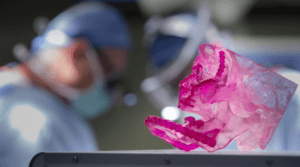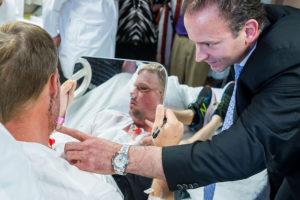Just 21 years old when he succumbed to a deep depression and suffered a self-inflicted rifle shot to the head in 2006, Andrew (Andy) Sandness of Newcastle, Wyoming realized quickly he was not yet done with the world. His injuries, however, were extensive, as the shot from below his chin had mangled his face beyond the capabilities of most cosmetic reconstructive procedures. He remained resilient, relying on prosthetics and a series of surgeries — and a strong relationship with his medical teams. In 2012, he learned that the Mayo Clinic, where he had been receiving treatment since the original injury, would be pursuing the creation of a face transplant program for the first time… and he would be a good potential candidate. While his doctor, Dr. Samir Mardini, a plastic surgeon specializing in facial reconstruction, cautioned him to remain realistic about the prospects, Sandness chose to press on at every turn. With the approval of the Mayo Clinic’s face transplant program three years later, Sandness ultimately found himself to indeed be a good candidate, having passed a thorough series of physical, psychiatric, and social evaluations throughout the process.
 At the beginning of 2016, Sandness’ name was officially added to the waiting list for the United Network for Organ Sharing; it was only a few months later, in June, that a viable match was found. The donor, 21-year-old Calen “Rudy” Ross, was a registered organ donor. With the donor such a close match to Sandness — not only, as it turned out, in age range, complexion, and matching blood and tissue types, but as a young man who loved the outdoors and suffered from a self-inflicted gunshot wound to the head, fatal in Ross’ case — the team at the Mayo Clinic sprung into action for the surgery, which began on June 16, 2016, and lasted for 56 hours. The procedure required 24 hours to harvest the donor skin, tissue, bone, muscle, and nerves while preparing Sandness to receive these; 32 hours in the OR rebuilt his face.
At the beginning of 2016, Sandness’ name was officially added to the waiting list for the United Network for Organ Sharing; it was only a few months later, in June, that a viable match was found. The donor, 21-year-old Calen “Rudy” Ross, was a registered organ donor. With the donor such a close match to Sandness — not only, as it turned out, in age range, complexion, and matching blood and tissue types, but as a young man who loved the outdoors and suffered from a self-inflicted gunshot wound to the head, fatal in Ross’ case — the team at the Mayo Clinic sprung into action for the surgery, which began on June 16, 2016, and lasted for 56 hours. The procedure required 24 hours to harvest the donor skin, tissue, bone, muscle, and nerves while preparing Sandness to receive these; 32 hours in the OR rebuilt his face.
 For its incredible complexity, however, the surgery was not so daunting as it might have been; the medical team were incredibly well prepared. A team of close to 60 had dedicated three and a half years and more than 50 Saturdays to practicing the procedure, thanks to 3D imaging and virtual surgical procedures, as well as cadavers.
For its incredible complexity, however, the surgery was not so daunting as it might have been; the medical team were incredibly well prepared. A team of close to 60 had dedicated three and a half years and more than 50 Saturdays to practicing the procedure, thanks to 3D imaging and virtual surgical procedures, as well as cadavers.
As the Mayo Clinic notes, the team included “specialists from Plastic and Reconstructive Surgery, Transplant Medicine, Neurology, Ophthalmology, Dermatology, Radiology, Critical Care, Anesthesia, Psychiatry, Infectious Diseases, Immunology, Pharmacy, Regenerative Medicine, Nursing, Social Work, Rehabilitation, and Speech and Language Pathology,” as well as staff from LifeSource.
Among the tools in their arsenal were a 3D printed surgical guide and model, created by 3D Systems. As we have seen, the company is devoting extensive resources to healthcare applications, including in complex operations encompassing a previous highly involved face transplant. 3D models helped to ready the team, and the cutting guide ensured that the surgeons would be precise in their well-practiced cuts as they fitted the new tissue onto Sandness’ face.
This brief animation from the Mayo Clinic details the extent of the transplant and shows the cutting guides 3D Systems created:
“Using this technology of 3D modeling, printing and virtual surgical planning is extremely beneficial. They would have cutting guides for us that we would clip on the bones. They would give us the exact location of the cut, exact angle of the cut, so when we took the donor’s face and put it on the recipient, it would fit perfectly,” Dr. Mardini said of the technology.
Following the operation, which Sandness had not doubted for a moment would be a success, he was not allowed to see himself for a few weeks as the healing process began post-op, following a few days’ sedation. Three weeks later, he looked into a mirror for the first time. Unable to speak yet, aside from a quick “Wow”, he wrote on a notepad: “Far exceeded my expectations.”
A few months after the marathon transplant surgery, Sandness underwent a second surgery “to refine his appearance, to speed up the regeneration of sensory nerves to his cheeks, and to improve his tongue function.”
“Mayo Clinic has a long history of specialized teams of experts providing complex care to patients who need hope and healing. This is an extraordinary example of the teamwork, collaboration and compassion that we provide at Mayo Clinic, and I couldn’t be more proud of this team. Andy has been our patient for 10 years. He has worked so hard to prepare for this, and during his entire recovery period, he has been strong, gracious and determined. Andy is an amazing person and so well-deserving of this gift,” Dr. Mardini said of the experience.
Only a few dozen face transplants have ever taken place. As 3D printing technologies continue to come into play, we are sure to see more successes in highly complex procedures such as face transplants, for which planning and precision are utterly necessary. In Sandness’ case, his new face is giving him a new lease on life, and new comfort in facing his world.
“I am absolutely amazed at the outcome so far. I am now able to chew and eat normal food, and the nerve sensation is slowly improving, too. My confidence has improved, and I’m feeling great ― and grateful. I am so thankful to my donor and the donor’s family, and to all of the people who have supported me throughout this process,” Sandness said.
“I was just absolutely blown away by the results. I just feel like a normal person walking around outside. Going to the shopping malls, nobody stares. I feel normal; feel like another face in the crowd. And now, with this transplant, I just feel more confident and more comfortable doing these things.”
We’ll be hearing right from the team at 3D Systems soon to bring more details of this case to you. You can see more of this incredible story in this video from the Mayo Clinic:
Discuss in the Mayo Clinic forum at 3DPB.com.
[Sources: Mayo Clinic, AP / All images/video: Mayo Clinic]
Subscribe to Our Email Newsletter
Stay up-to-date on all the latest news from the 3D printing industry and receive information and offers from third party vendors.
You May Also Like
Gorilla Sports GE’s First 3D Printed Titanium Cast
How do you help a gorilla with a broken arm? Sounds like the start of a bad joke a zookeeper might tell, but it’s an actual dilemma recently faced by...
Nylon 3D Printed Parts Made More Functional with Coatings & Colors
Parts 3D printed from polyamide (PA, Nylon) 12 using powder bed fusion (PBF) are a mainstay in the additive manufacturing (AM) industry. While post-finishing processes have improved the porosity of...
$25M to Back Sintavia’s Largest Expansion of Metal 3D Printing Capacity Since 2019
Sintavia, the digital manufacturing company specializing in mission-critical parts for strategic sectors, announced a $25 million investment to increase its production capacity, the largest expansion to its operations since 2019....
Velo3D Initiates Public Offering in a Bid to Strengthen Financial Foundations and Drive Future Growth
Velo3D (NYSE: VLD) has been among a number of publicly traded 3D printing firms that have attempted to weather the current macroeconomic climate. After posting a challenging financial report for 2023,...





































